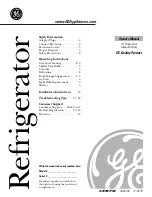
15
7: CLEANING AND MAINTENANCE
1. To clean the refrigerator, disconnect power supply and remove foods, shelves, trays
etc. Use a solution mixed with 2 spoons of baking soda per litre of warm water to clean
the interior. Then wipe it clean with fresh water.
Never use acids, chemical thinner, gasoline, benzene or the like for cleaning any part of
the refrigerator.
Never use oiling water and benzene to clean plastic parts because they may deform or
damage the plastic parts.
2. Too much foods or a too large container in the refrigerator will affect cold air circulation,
so some free space must be left. It is recommended that about 70% storage volume is
loaded.
Do not store volatile and or explosive materials such as ethers, gasoline, liquefied
petroleum gas, adhesives etc. in the refrigerator. Otherwise there will be a danger of
explosion caused by electric sparks.
8
. SAFETY INSTRUCTIONS
Before plugging your refrigerator in check that the electric supply in your house must
comply with the rating (voltage, frequency) of the refrigerator, the rating plate is usually
on the back of the refrigerator. The refrigerator should always be plugged in its own
individual electrical outlet to prevent overload, which could cause a possible fire hazard
from overheating wires. Do not splash water on the refrigerator as this will cause
electrical leakage or failure. If the power cord becomes damaged, ask on electrician to
replace it immediately. The refrigerator must be properly earthed.
Our corporation is not responsible for any accident caused by improper earthing or
improper operation.
Any repairs and work on the appliance should only be carried out by the customer service
department, as unauthorized work could prove highly dangerous for the user.
Do not store explosives or sprays using combustible propellants such as butane,
propane, pentane etc. In the appliance, Electrical components might cause leaking gas
to ignite. You may identify such sprays by the printed contents or a flame symbol.
Do not allow naked flames or ignition sources to enter the appliance.
Do not use steam cleaners for defrosting and cleaning.
Do not use mechanical devices or other means to accelerate the defrosting process,
other than those recommended by the manufacturer.
Do not damage the refrigerant circuit.







































